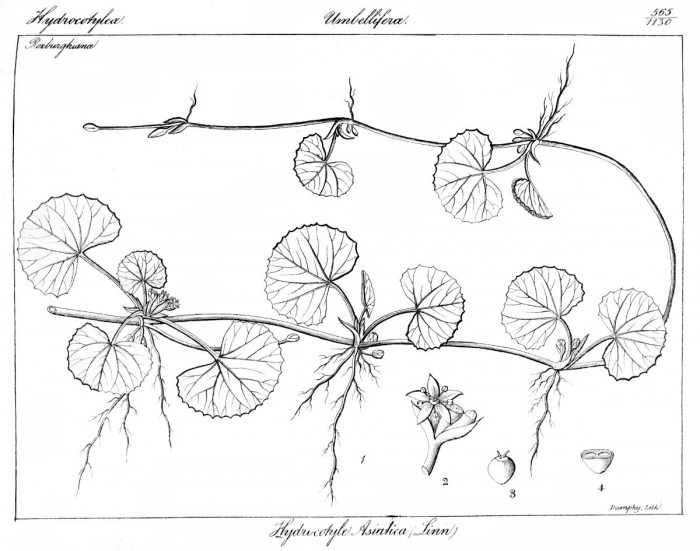Centella asiatica (L.) Urb. - syn. Hydrocotyle asiatica L.; Hydrocotyle erecta L. f. - Apiaceae
Indian pennywort, Indian water navelwort, gotu kola, Asiatisches Sumpfpfennigkraut, Indischer Wassernabel, Gotu Kola
Perennial herb, native to East Africa, Pakistan, India, East and Southeast Asia, Australia, Pacific Islands and South America, natirailzed and cultivated elsewhere; leaves orbicular or reniform, with 5-7 prominent palmate veins, base broadly cordate, coarsely toothed; umbels 3-4-flowered, flower petals white or rose-tinged.
http://www.efloras.org/florataxon.aspx?flora_id=2&taxon_id=200015478
„It is used as a medicinal herb in Ayurvedic medicine, traditional African medicine, and traditional Chinese medicine… Centella is used as a leafy green in Sri Lankan cuisine, where it is called gotu kola. In Sinhalese, gotu is translated as „conical shape“ and kola as „leaf“. It is most often prepared as malluma (මැල්ලුම), a traditional accompaniment to rice and curry, and goes especially well with vegetarian dishes, such as dhal, and jackfruit or pumpkin curry.“ https://en.wikipedia.org/wiki/Centella_asiatica
α-Humulene (21.0%), β-caryophyllene (19.0%), bicyclogermacrene (11.2%), germacrene B (6.2%), and myrcene (6.5%) were the predominant constitutes of the essential oil of C.asiatica.
[Chemical composition and antibacterial activity of the essential oil of Centella asiatica growing in South Africa., Oyedeji, O.A., Afolayan, A.J., Pharmaceutical Biology, 43(3), 2005, 249-252]
„The flavour characteristics of fresh and processed pennywort juices treated by pasteurisation, sterilisation and high pressure processing (HPP) were investigated by using solid-phase micro-extraction combined with gas chromatography–mass spectrometry. Sesquiterpene hydrocarbons comprise the major class of volatile components present and the juices had a characteristic smell due to the presence of volatile compounds including β-caryophyllene, humulene, E-β-farnesene, α-copaene, alloaromadendrene and β-elemene. All processing operations caused a reduction in the total volatile concentration, but HPP caused more volatile acyclic alcohols, aldehydes and oxygenated monoterpenoids to be retained than pasteurisation and sterilisation. Ketones were not present in fresh pennywort juice, but 2-butanone and 3-nonen-2-one were generated in all processed juices, and 2-nonanone and 2-hexanone were present in pasteurised and sterilised juices. Other chemical changes including isomerisation were also reduced by HPP compared to pasteurisation and sterilisation…
Fresh juice was characterized by a high content of the oxygenated monoterpenes; linalool (335.5 ng/L), geraniol (146.9 ng/L) and β-cyclocitral (42.5 ng/L) and the sesquiterpenoid hydrocarbons β-caryophyllene (1344.0 ng/L) and humulene (1602.2 ng/L) were present at higher concentrations in the fresh juice than other volatiles.“
[Flavour characterisation of fresh and processed pennywort (Centella asiatica L.) juices., Wongfhun, P., Gordon, M.H., Apichartsrangkoon, A., Food chemistry, 119(1), 2010, 69-74] http://centaur.reading.ac.uk/4634/1/Flavour_Paper_2_final_full_paper.doc
„Asiaticoside derived from the plant Centella asiatica is known to possess good wound healing activity… Asiaticoside application (0.2%, topical) twice daily for 7 days to excision-type cutaneous wounds in rats led to increased enzymatic and non-enzymatic antioxidants, namely superoxide dismutase (35%), catalase (67%), glutathione peroxidase (49%), vitamin E (77%) and ascorbic acid (36%) in newly formed tissues. It also resulted in a several fold decrease in lipid peroxide levels (69%) as measured in terms of thiobarbituric acid reactive substance. However, continued application for 14 days showed no significant difference in these antioxidants compared with their values in vehicle treated wound tissue. It appears from the present study that asiaticosides enhanced induction of antioxidant levels at an initial stage of healing which may be an important contributory factor in the healing properties of this substance.“
[Asiaticoside‐induced elevation of antioxidant levels in healing wounds., Shukla, A., Rasik, A.M., Dhawan, B.N., Phytotherapy Research, 13(1), 1999, 50-54]
„Centella asiatica accumulates large quantities of pentacyclic triterpenoid saponins, collectively known as centelloids. These terpenoids include asiaticoside, centelloside, madecassoside, brahmoside, brahminoside, thankuniside, sceffoleoside, centellose, asiatic-, brahmic-, centellic- and madecassic acids. The triterpene saponins are common secondary plant metabolites and are synthesized via the isoprenoid pathway to produce a hydrophobic triterpenoid structure (aglycone) containing a hydrophilic sugar chain (glycone)… Various saponins occur in C. asiatica due to the location and diverse environmental conditions…“
[Pentacyclic triterpenoids from the medicinal herb, Centella asiatica (L.) Urban., James, J.T., Dubery, I.A., Molecules, 14(10), 2009, 3922-3941] http://www.mdpi.com/1420-3049/14/10/3922/pdf
„Most of the clinical studies on Asian CA have been realized with alcoholic or aqueous extracts. The TECA extracts (titrated extracts of Asian CA and TTFCA (triterpenic total fraction of Asian CA) are combinations of asiatic acid (30%), madecasic acids (30%) and asiaticoside (40%). The TTF extract (triterpenic total fraction) consists of Asian CA and madecasic acids (60%) in a relation not clearly defined yet, in combination with asiaticoside (40%).“
[Pharmacological review on Centella asiatica: a potential herbal cure-all., Gohil, K.J., Patel, J.A., Gajjar, A.K., Indian journal of pharmaceutical sciences, 72(5), 2010, 546] http://www.ncbi.nlm.nih.gov/pmc/articles/PMC3116297/
„Centella asiatica known as Gotu Kola is a medicinal plant that has been used in folk medicine for hundreds of years as well as in scientifically oriented medicine. The active compounds include pentacyclic triterpenes, mainly asiaticoside, madecassoside, asiatic and madecassic acids. Centella asiatica is effective in improving treatment of small wounds, hypertrophic wounds as well as burns, psoriasis and scleroderma. The mechanism of action involves promoting fibroblast proliferation and increasing the synthesis of collagen and intracellular fibronectin content and also improvement of the tensile strength of newly formed skin as well as inhibiting the inflammatory phase of hypertrophic scars and keloids. Research results indicate that it can be used in the treatment of photoaging skin, cellulite and striae.“
[Centella asiatica in cosmetology., Bylka, W., Znajdek-Awiżeń, P., Studzińska-Sroka, E., Brzezińska, M., Advances in Dermatology and Allergology/Postȩpy Dermatologii I Alergologii, 30(1), 2013, 46] http://www.ncbi.nlm.nih.gov/pmc/articles/PMC3834700/

Centella asiatica as Hydrocotyle asiatica, Wight,R., Icones Plantarum Indiae Orientalis, vol.2(1) t.565 (1846)
http://plantgenera.org/species.php?id_species=220774